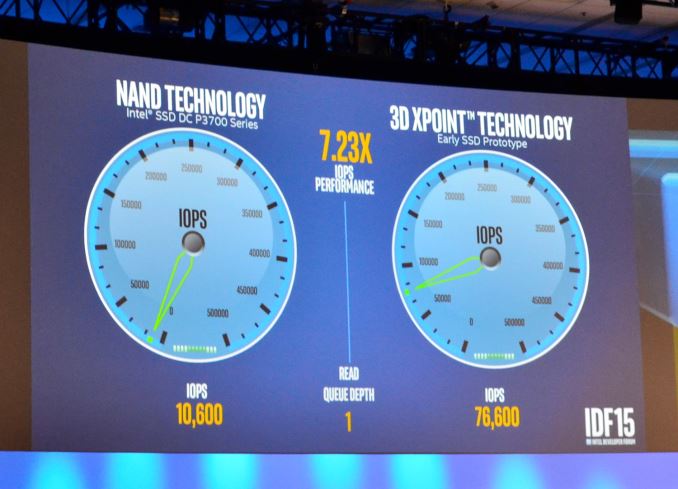Intel Announces Optane Storage Brand For 3D XPoint Products
by Ryan Smith on August 18, 2015 2:15 PM EST
At IDF 2015 this year Intel has announced that their forthcoming 3D XPoint technology based products will be sold under a new brand for the company, Optane.
The Optane products will be available in 2016, in both standard SSD (PCIe) form factors for everything from Ultrabooks to servers, and in a DIMM form factor for Xeon systems for even greater bandwidth and lower latencies. As expected, Intel will be providing storage controllers optimized for the 3D XPoint memory, though no further details on that subject matter were provided. This announcement is in-line with Intel and Micron’s original 3D XPoint announcement last month, which also announced that 3D XPoint would be out in 2016.
Finally, as part of the Optane announcement, Intel also gave the world’s first live 3D XPoint demonstration. In a system with an Optane PCIe SSD, Intel ran a quick set of live IOps benchmarks comparing the Optane SSD to their high-end P3700 SSD. The Optane SSD offered better than 5x the IOps of the P3700 SSD, with that lead growing to more than 7x at a queue depth of 1, a client-like workload where massive arrays of NAND like the P3700 traditionally struggle to achieve maximum performance.












50 Comments
View All Comments
vlado08 - Tuesday, August 18, 2015 - link
So instead of 1000x it actually is 7x faster?extide - Tuesday, August 18, 2015 - link
It was never supposed to be 1000x faster in this scenario. It will be a lot faster (more than 5-7x) when doing write workloads, though.However THIS kind of performance is exactly what we need. High performance at *low queue depths* ! Pretty much all SSD's have given us lots of performance at high queue depths for a while now, but most real world client workloads are LOW queue depth.
witeken - Tuesday, August 18, 2015 - link
1000x faster is literally faster; lower latency.Impulses - Tuesday, August 18, 2015 - link
Even 7x could be pretty impressive depending on price... That's a bigger jump than we've seen out of any single SSD since the X25 days. I was skeptical they'd price this in any sort of mainstream way out of the gate but if they're talking about Ultrabooks...Could this threaten NAND based PCI-E SSD (at 2x the premium of SATA drives) before they even take hold of the market?
Flunk - Tuesday, August 18, 2015 - link
NAND based PCI-E SSDs will be available for only slightly more than SATA ones very soon. Why? There isn't a big cost difference to make them and competition will force it.Impulses - Wednesday, August 19, 2015 - link
There'd have to be more of a demand for competition to matter... If Samsung hasn't bothered taking SM951 to retail demand can't be that great. Hope you're right tho, already bought one myself but lower prices would mean more pressure for 3D Xpoint etc etc.frenchy_2001 - Monday, August 24, 2015 - link
You need a large enough market to justify retail costs.OEM distribution is a lot more efficient: less contacts, less support, single point of negociation, fixed prices, contracted volumes...
Retail will come once enough products that can use it are available in the market and an upgrade product would make sense.
PCIe NVMe drives will come. The whole market is bullish about it, multiple controller houses have chips for it. Lots of demos for it a Flash Memory Summit early August. Should be here by xmas hopefully or early next year.
lilmoe - Tuesday, August 18, 2015 - link
This is probably without any sort of parallelism.jjj - Tuesday, August 18, 2015 - link
They are insisting on read (and a bit of mixed) so got to wonder how slow write is for now.frenchy_2001 - Monday, August 24, 2015 - link
Writes is supposed to be where the biggest gains are:- bit access: you do not need to erase a full page to modify one bit
- faster writes
Intel is revealing the pieces one at a time to keep people interested till 2016.